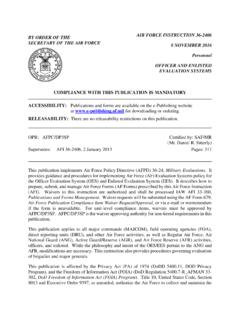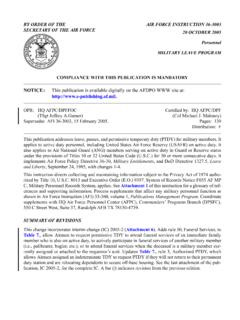Transcription of BY ORDER OF THE AIR FORCE HANDBOOK 36-2618 …
1 BY ORDER OF THE SECRETARY OF THE AIR FORCE AIR FORCE HANDBOOK 36-2618 5 JULY 2018 Personnel THE ENLISTED FORCE STRUCTURE ACCESSIBILITY: Publications and forms are available for downloading or ordering on the e-Publishing website at RELEASABILITY: There are no releasability restrictions on this publication. OPR: AF/A1D Supersedes: AFI36-2618, 27 February 2009 Certified by: SAF/MR (Dr. Todd A. Fore) Pages: 26 This HANDBOOK defines the Air FORCE enlisted FORCE structure and implements Air FORCE Policy Directive 36-26, Total FORCE Development and Management. It has been developed in collaboration between the Deputy Chief of Staff for Manpower, Personnel and Services (AF/A1), the Chief of the Air FORCE Reserve (AF/RE) and the Director of the Air National Guard (NGB/CF), and applies to all Regular Air FORCE members, members of Air FORCE Reserve Command, and members of the Air National Guard.
2 Ensure that all records created as a result of processes prescribed in this publication are maintained in accordance with Air FORCE Manual 33-363, Management of Records, and disposed of in accordance with Air FORCE Records Information Management System Records Disposition Schedule. Refer recommended changes and questions about this publication to AF/A1DI using Air FORCE Form 847, Recommendation for Change of Publication. Route Air FORCE Form 847 from the field through the appropriate functional chain of command. This publication may be supplemented at any level, but all supplements that directly implement this publication must be routed to the Office of Primary Responsibility for coordination, and all Major Command-level supplements must be approved by the Human Resource Management Strategic Board prior to certification and approval.
3 The use of the name or mark of any specific manufacturer, commercial product, commodity, or service in this publication does not imply endorsement by the Air FORCE . SUMMARY OF CHANGES This HANDBOOK replaces Air FORCE Instruction 36-2618 , 27 February 2009. 2 AFH3-2618 5 JULY 2018 CORRECTIVE ACTIONS APPLIED ON 12 JULY 2018 Chapter 1 INTRODUCTION 3 The Enlisted FORCE Structure.. 3 Purpose of the Enlisted FORCE Structure.. 3 Chapter 2 AIR FORCE LEADERSHIP LEVELS 4 Air FORCE Leadership Levels.. 4 Chapter 3 THE ENLISTED FORCE STRUCTURE 6 Tiers, Ranks, and Roles.. 6 Chapter 4 RESPONSIBILITIES 9 Commanders and 9 Supervisors.. 9 Wingmen.. 9 Junior Enlisted Airmen Responsibilities.
4 9 Noncommissioned Officer Responsibilities.. 11 Senior Noncommissioned Officer Responsibilities.. 12 Chapter 5 ENLISTED DUTY TITLES 14 Enlisted Duty Titles.. 14 Chapter 6 SPECIAL ENLISTED POSITIONS 16 Special Enlisted Positions.. 16 Developmental Special Duties.. 19 Chapter 7 OFFICER AND CIVILIAN FORCE STRUCTURES 23 Enlisted Airmen Responsibilities.. 23 Officer FORCE Structure.. 23 Civilian FORCE Structure.. 23 Attachment 1 GLOSSARY OF REFERENCES AND SUPPORTING INFORMATION 24 Attachment 2 THE AIRMAN S CREED 25 Attachment 3 ENLISTED CAREER PYRAMID 26 AFH3-2618 5 JULY 2018 CORRECTIVE ACTIONS APPLIED ON 12 JULY 2018 3 Chapter 1 INTRODUCTION The Enlisted FORCE Structure.
5 The Air FORCE is a diverse group of functionally and operationally specialized Airmen in the profession of arms. Despite the differences across functional and operational lines, there is a compelling need for a deliberate and common approach to FORCE development, career progression, and the assumption of increased supervisory and leadership responsibilities. To best leverage our resources, we must have a consistent, well-defined set of expectations, standards, and opportunities for the growth for all Airmen, regardless of rank or specialty. This is accomplished through the enlisted FORCE structure and FORCE development constructs which rely on Air FORCE institutional competencies.
6 FORCE Development. All elements of FORCE development education, training and experience are tethered to the enlisted FORCE structure and institutional competencies. The institutional competencies are the leadership, management, and readiness qualities Airmen require to lead and operate in the profession of arms. Every FORCE development action, from Basic Military Training, to professional military education to strategic engagement opportunities, is linked to the institutional competencies. These competencies provide a common language, set of priorities, and proficiency expectation based on an Airman s rank, experience and/or position. The enlisted FORCE structure and institutional competencies describe what makes us Airmen, not just functional specialists.
7 We are Airmen first, specialists second. Airmanship. Airmanship represents the commitment to a culture of pride and professionalism by all Airmen. The Airmanship mindset reflects Airmen committed to the Air FORCE family values, motivated by our Airman s Creed, Warrior Ethos, inspired by our heritage, and is built upon the Air FORCE Core Values. Core Values. The enlisted FORCE structure, FORCE development, and institutional competencies are grounded in the Air FORCE core values (Integrity First, Service Before Self, and Excellence in All We Do). These values are the thread that weaves through Air FORCE policies, guidance, and focus areas. Simply put, they influence Air FORCE activities and Airmen s actions.
8 Purpose of the Enlisted FORCE Structure. This instruction provides the general framework for the enlisted FORCE structure that best meets mission requirements, while developing institutional and occupational competencies. Additionally, it defines the leadership levels, tiers, ranks, roles, terms of address, general responsibilities, duty titles and special positions for the enlisted forces. The enlisted FORCE structure provides a framework for supervisors as they set standards during initial feedback sessions, evaluate progress during mid-term feedback sessions, and document performance on annual reports. 4 AFH3-2618 5 JULY 2018 CORRECTIVE ACTIONS APPLIED ON 12 JULY 2018 Chapter 2 AIR FORCE LEADERSHIP LEVELS Air FORCE Leadership Levels.
9 The Air FORCE operates in a dynamic global context across multiple domains requiring leadership skills at three distinct levels: tactical expertise, operational competence, and strategic vision. These levels emphasize a different mix of qualities and experience. The leadership level at which an Airman operates determines the institutional competencies required to lead Airmen in mission accomplishment. As Airmen progress from the tactical expertise to strategic vision leadership levels, emphasis on the use of institutional competencies shifts from personal to organizational, with a generally consistent focus on people/team competencies. The nature and scope of leadership challenges as well as preferred leadership methods differ based on the level of leadership and duties.
10 These levels apply across the entire spectrum of the enlisted FORCE structure. Tactical Expertise. This level is predominantly direct and face-to-face and focused on personal competencies. At the tactical expertise level, Airmen gain a general understanding of team leadership and an appreciation for organization leadership. They master their core duty skills, develop experiences in applying those skills, and begin to acquire the knowledge and experience that will produce the qualities essential to effective leadership. Airmen at the tactical expertise level gain the training, education and experience to become the Air FORCE s primary technicians and specialists. They learn about themselves as leaders and how their leadership acumen can affect others through the use of ethical leadership.















